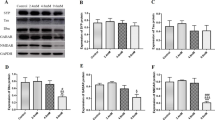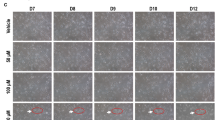Abstract
Triethyl lead is the major metabolite of tetraethyl lead, which is used in industrial processes and as an antiknock additive to gasoline. We tested the hypothesis that low levels of triethyl lead (0.1 nmol/L to 5μmol/L) interfere with the normal development of cultured E18 rat hippocampal neurons, possibly through increases in intracellular free calcium ion concentration, [Ca2+]in. The study assessed survival and differentiation using morphometric analysis of individual neurons. We also looked at short-term (up to 3.75-h) changes in intracellular calcium using the calcium-sensitive dye fura-2. Survival of neurons was significantly reduced at 5 μmol/L, and overall production of neurites was reduced at ≥2 μmol/L. The length of axons and the number of axons and dendrites were reduced at ≥1 μmol/L. Neurite branching was inhibited at 10 nmol/L for dendrites and 100 nmol/L for axons. Increases in intracellular calcium were observed during a 3.75-h exposure of newly plated neurons to 5 μmol/L triethyl lead. These increases were prevented by BAPTA-AM; which clamps [Ca2+]in at about 100 nmol/L. Culturing neurons with BAPTA-AM and 5 μmol/L triethyl lead did not reverse the effects of triethyl lead, suggesting that elevation of [Ca2+]in is not responsible for decreases in survival and neurite production. Triethyl lead has been shown to disrupt cytoskeletal elements, particularly neurofilaments, at very low levels, suggesting a possible mechanism for its inhibition of neurite branching at nanomolar concentrations.
Similar content being viewed by others
Abbreviations
- BAPTA-AM:
-
1,2-bis(2-aminophenoxy)ethane-N,N,N′,N′-tetraacetic acid acetoxymethyl ester
- [Ca2+]in :
-
intracellular free calcium ion concentration
- DMSO:
-
dimethyl sulfoxide
- E18:
-
embryonic day 18
- FBS:
-
fetal bovine serum
- fura-2AM:
-
fura-2 acetoxymethyl ester
- HBSS:
-
Hanks' Balanced Salt Solution
- MEM:
-
Eagle's Minimum Essential Medium
References
Anglister L, Farber IC, Shahar A, Grinvald A. Localization of voltage-sensitive calcium channels along developing neurites: their possible role in regulating neurite elongation. Dev Biol. 1982;94:351–65.
Audesirk G, Shugarts D, Nelson G, Przekwas J. Organic and inorganic lead inhibit neurite growth in vertebrate and invertebrate neurons in culture. In Vitro Cell Dev Biol. 1989; 25:1121–8.
Audesirk G, Audesirk T, Ferguson C et al. L-Type calcium channels may regulate neurite initiation in cultured chick embryo brain neurons and N1E-115 neuroblastoma cells. Dev Brain Res. 1990;55:109–20.
Audesirk T, Audesirk G, Ferguson C, Shugarts D. Effects of lead on the differentiation and growth of cultured hippocampal and neuroblastoma cells. NeuroToxicol. 1991;12:529–38.
Booze RM, Mactutus CF. Developmental exposure to organic lead causes permanent hippocampal damage in Fischer-344 rats. Experientia. 1990;46:292–7.
Carafoli E. Intracellular calcium homeostasis. Annu Rev Biochem. 1987;56:395–433.
Cremer JE. Possible mechanisms for the selective neurotoxicity. In: Grandjean P, ed. Biological effects of organolead compounds. Baton Rouge, FL: CRC Press; 1984:207–19.
Cragg BG, Rees S. Increased body:brain weight ratio in developing rats after low exposure to organic lead. Exp Neurol. 1984;86:113–21.
Ferris NJ, Cragg BG. Organic lead and histological parameters of brain development. Acta Neuropathol. 1984;63:306–12.
Grandjean P, Nielsen T. Organolead compounds: Environmental health aspects. Residue Rev. 1979;72:97–148.
Goslin K, Banker G. Rat hippocampal neurons in low-density culture. In: Banker G, Goslin K, eds. Cambridge, MA: MIT Press; 1991:251–81.
Grundt IK, Amitzboll T, Clausen J. Triethyllead treatment of cultured brain cells. Neurochem Res. 1981;6:193–201.
Grynkiewicz G, Poenie M, Tsien RY. A new generation of Ca2+ indicators with greatly improved fluorescence properties. J Biol Chem. 1985;260:3440–50.
Hantez-Ambrose D, Trautman A. Effects of calcium ion on neurite outgrowth of rat spinal cord neuronsin vitro: the role of non-neuronal cells in regulating neurite sprouting. Int J Dev Neurosci. 1989;7:591–602.
Holliday J, Spitzer NC. Spontaneous calcium influx and its roles in differentiation of spinal neurons in culture. Dev Biol. 1990;141:13–23.
Johnson GVW, Greenwood JA, Costello AC, Troncoso JC. The regulatory role of calmodulin in the proteolysis of individual neurofilament proteins by calpin. Neurochem Res. 1991;16:869–73.
Kater SB, Mattson MP, Cohan C, Connor J. Calcium regulation of the neuronal growth cone. Trends NeuroSci. 1988;11:315–21.
Kauppinen RA, Komulainen H, Taipale HT. Chloride-dependent uncoupling of oxidative phosphorylation by triethyllead and triethyltin increases cytosolic free calcium in guinea pig cerebral cortical synaptosomes. J Neurochem. 1988;51:1617–25.
Komulainen H, Bondy SC. Increased free intrasynaptosomal Ca2+ by neurotoxic organometals: Distinctive mechanisms. Toxicol Appl Pharmacol. 1987;88:77–86.
Konat G. Triethyllead and cerebral development: An overview. NeuroToxicol. 1984;5:87–96.
Matthews EK. Calcium and membrane permeability. Br Med Bull. 1986;42:391–7.
Mattson MP. Calcium as sculptor and destroyer of neural circuitry. Exp Gerontol. 1992;27:29–49.
Mattson MP, Kater SB. Calcium regulation of neurite elongation and growth cone motility. J Neurosci. 1987;7:4034–43.
Mattson MP, Kater SB. Isolated hippocampal neurons in cryopreserved long-term cultures: Development of neuroarchitecture and sensitivity to NMDA. Int J Dev Neurosci. 1988;6:439–52.
Mattson MP, Murain M, Guthrie PB. Localized calcium influx orients axon formation in embryonic hippocampal pyramidal neurons. Dev Brain Res. 1990;52:201–9.
Nicholls DG. Intracellular calcium homeostasis. Br Med Bull. 1986;4:353–8.
Nielsen T, Jensen KA, Grandjean P. Organic lead in normal human brains. Nature. 1978;274:602–3.
Niklowitz WJ. Ultrastructural effects of acute triethyllead poisoning on nerve cells of the rabbit brain. Environ Res. 1974;8:17–36.
Robson SJ, Burgoyne RD. L-Type calcium channels in the regulation of neurite outgrowth from rat dorsal root ganglion neurons in culture. Neurosci Lett. 1989;104:110–4.
Röderer G, Doenges KH. Influence of trimethyl lead and inorganic lead on thein vitro assembly of microtubules from mammalian brain. NeuroToxicol. 1983;4:171–80.
Rogers M, Hendry I. Involvement of dihydropyridine-sensitive calcium channels in nerve growth factor-dependent neurite outgrowth by sympathetic neurons. J Neurosci Res. 1990;26:447–54.
Schlaepfer WW. Neurofilaments: Structure, metabolism and implications in disease. J Neuropathol Exp Neurol. 1987;46:117–29.
Silver RA, Lamb AG, Bolsover SR. Calcium hotspots caused by L-channel clustering promote morphological changes in neuronal growth conses. Nature. 1990;343:751–4.
Tsien RY. New calcium indicators and buffers with high selectivity against magnesium and protons: Design, synthesis, and properties of prototype structures. Biochemistry. 1980;19:2396–403.
Tymianski M, Wallace MC, Spigelman I et al. Cell permeant Ca2+ chelators reduce early excitotoxic and ischemic neuronal injuryin vitro andin vivo. Neuron. 1993;11:221–35.
Verity MA. Comparative observations on inorganic and organic lead neurotoxicity. Exp Health Persp. 1990;89:43–8.
Walsh TJ, Tilson HA. Neurobehavioral toxicology of the organoleads. NeuroToxicol. 1984;5:67–86.
Walsh TJ, McLamb RL, Bondy S, Tilson H, Chang LW. Triethyl and trimethyl lead: Effects on behavior, CNS morphology and concentrations of lead in blood and brain of rat. NeuroToxicol. 1986;7:21–34.
Wolff J. Regulation of thein vitro assembly of microtubules by calcium and calmodulin. In: Rousset BAF, ed. Structure and function of the cytoskeleton, vol. 171. Colloque INSERM: John Libbey Eurotext; 1988:477–90.
Yagminas AP, Little PB, Rousseaux CG, Franklin CA, Villeneuve DC. Neuropathologic findings in young male rats in a subchronic oral toxicity study using triethyl lead. Fundam Appl Toxicol. 1992;19:380–7.
Zimmerman H-P, Doenges KH, Röderer G. Interaction of triethyl lead chloride with microtubulesin vitro and in mammalian cells. Exp Cell Res. 1985;156:140–52.
Zimmerman H-P, Plagens U, Traub P. Influence of triethyl lead on neurofilamentsin vivo andin vitro. NeuroToxicol. 1987;8:569–78.
Author information
Authors and Affiliations
Rights and permissions
About this article
Cite this article
Audesirk, T., Shugarts, D., Cabell-Kluch, L. et al. The effects of triethyl lead on the development of hippocampal neurons in culture. Cell Biol Toxicol 11, 1–10 (1995). https://doi.org/10.1007/BF00769987
Received:
Accepted:
Issue Date:
DOI: https://doi.org/10.1007/BF00769987




